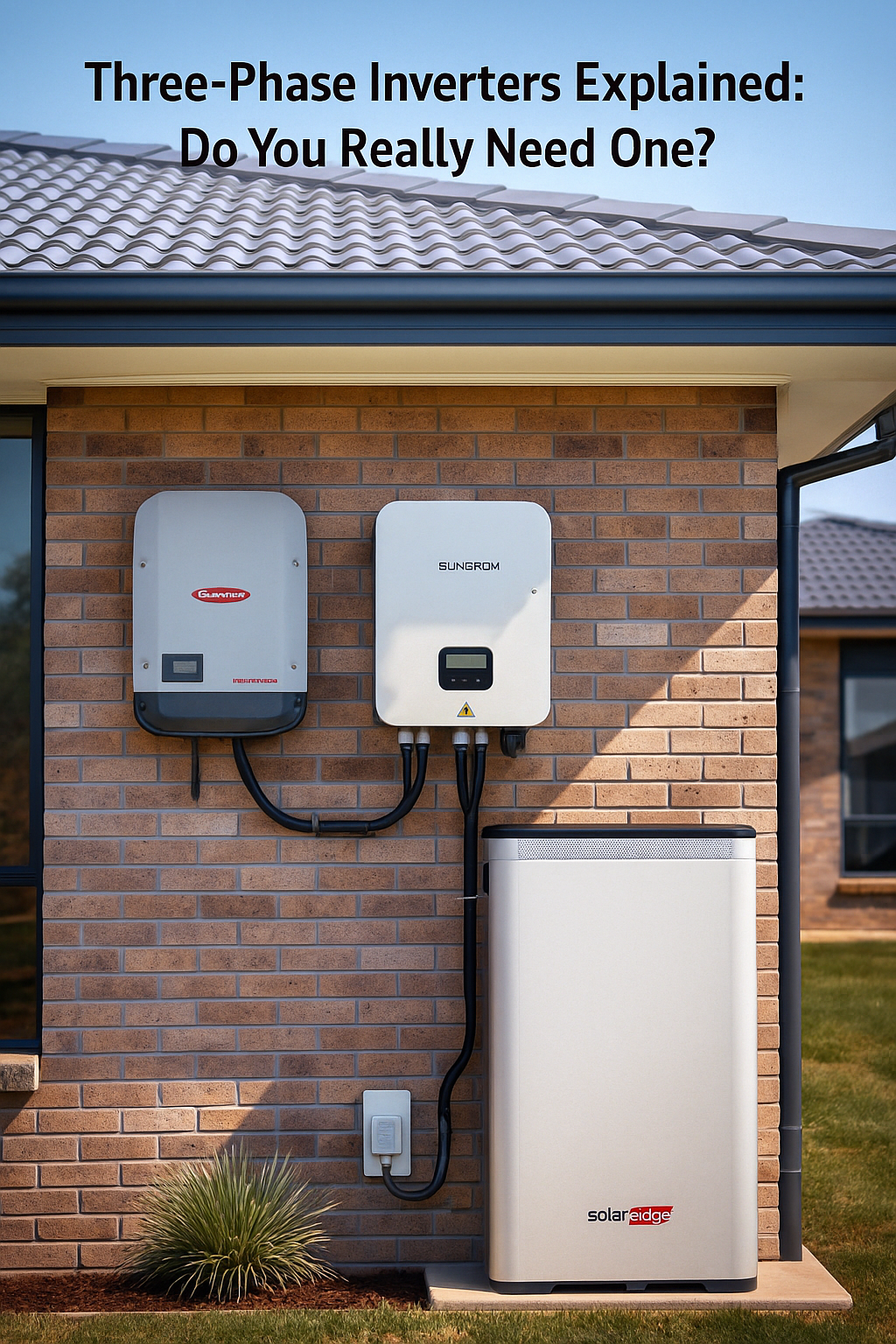If you’ve been researching solar systems, you’ve probably come across the term three-phase inverter. But what exactly does it mean, and is it something your home really needs?
In this guide, we’ll explain what three-phase power is, how these inverters work, and when investing in one makes the most sense — so you can make a confident choice before requesting your solar quotes.
What Is a Three-Phase Inverter?
To understand three-phase inverters, let’s start with your home’s electricity supply.
Most Australian homes use either single-phase or three-phase power.
- Single-phase power delivers electricity through one active wire and one neutral wire. It’s typical for smaller homes with average energy use.
- Three-phase power delivers electricity through three active wires. It provides smoother, higher-capacity power — ideal for large homes, properties with air conditioning, pools, or heavy appliances.
A three-phase inverter converts DC (direct current) electricity from your solar panels into AC (alternating current) electricity across all three phases evenly. This ensures balanced power delivery, less strain on the grid connection, and better overall efficiency.
How Does a Three-Phase Inverter Work?
Think of a three-phase inverter as a “power distributor.” Instead of sending all your solar energy through one wire (like a single-phase inverter does), it spreads it evenly across three.
Here’s what that means for you:
- Stable energy supply – smoother voltage and less flickering during heavy loads.
- Improved efficiency – less electrical loss during conversion.
- Balanced grid export – energy is fed evenly back to the grid.
Modern three-phase inverters also come with smart monitoring and battery-ready options, allowing seamless integration with home energy management systems.
Do You Need a Three-Phase Inverter at Home?
It depends on your home’s power setup and energy usage.
You need a three-phase inverter if:
- Your property has three-phase power (check your switchboard or ask your electrician).
- You plan to install a large solar system (above 10 kW).
- You use multiple high-load appliances, like ducted air conditioning, EV chargers, or pool pumps.
However, if your home has a single-phase connection and moderate energy use, a single-phase inverter might be perfectly fine — and more cost-effective.
Tip: If you’re unsure which type you have, a qualified solar installer can confirm it during your site assessment.
What About Solar Batteries?
Three-phase inverters and solar batteries are closely linked. Some batteries, like the Tesla Powerwall or Sungrow SBR series, integrate directly with three-phase systems for smoother charging and discharging.
If you plan to add a battery later, it’s worth discussing inverter compatibility during installation.
To explore whether a battery makes sense for your home, check this guide:
Are Solar Batteries Worth It?
Benefits of a Three-Phase Inverter
Here’s why many Australian homeowners and businesses upgrade to three-phase inverters:
✅ Higher efficiency: Better performance for larger systems.
✅ Future-proof design: Ready for batteries, EV chargers, or smart loads.
✅ Improved voltage balance: Reduces flickering and stress on wiring.
✅ Grid stability: Less likelihood of export limits from your energy retailer.
✅ Increased safety: Distributes energy more evenly across the system.
When Businesses Benefit Most
For commercial properties, farms, and workshops, three-phase inverters are often non-negotiable. They allow you to run heavy equipment, refrigeration, or machinery efficiently.
Additionally, businesses benefit from higher export caps and faster system payback periods — especially when paired with solar monitoring and automation tools.
For industry updates and sustainable energy solutions, check out Renew.org.au — a trusted source for renewable energy insights across Australia.
Cost Considerations
A three-phase inverter typically costs $800 – $1,500 more than an equivalent single-phase unit. However, the long-term performance benefits often outweigh the initial difference.
If you plan to install a 10 kW + system, invest in a home battery, or prepare for electric vehicle charging, this upgrade is well worth it.
Choosing the Right Installer
Selecting a qualified installer is crucial. An accredited professional will assess your power supply, load profile, and solar goals before recommending the right inverter type.
Compare verified quotes today: Request Solar Quotes
With multiple quotes from trusted installers, you’ll know whether a three-phase setup truly fits your needs — and what it should cost.
Your Next Steps
Three-phase inverters offer superior performance, stability, and scalability — but they’re not for everyone. If your property already uses three-phase power or you’re planning a larger system, it’s a smart investment.
✅ Step 1: Learn more about your energy setup at Renew.org.au
✅ Step 2: Explore battery compatibility → Are Solar Batteries Worth It?
✅ Step 3: Compare local quotes → Request Solar Quotes
With the right advice, you’ll enjoy balanced, efficient, and future-ready solar power for decades.

